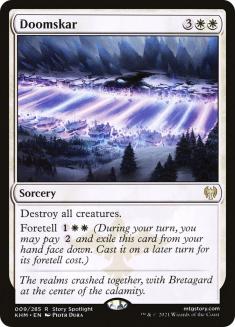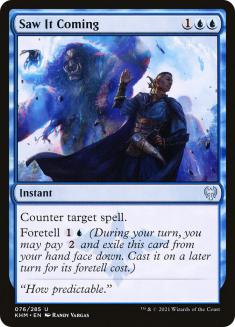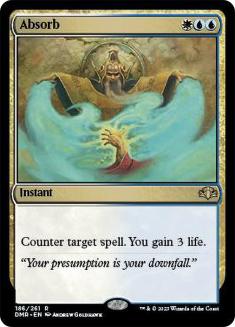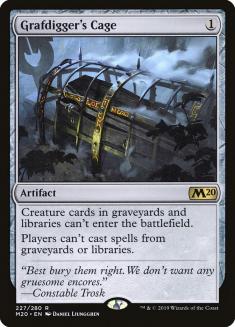The removal of Uro, Titan of Nature’s Wrath across the competitive spectrum has sent shockwaves through each metagame. We all knew the Elder Giant had to go — some of us knew from the first day — but the delay in its removal created glaring power vacuums. Decks that tried to play it fairly were dead on arrival in each format Uro was in. Aggressive decks could not combat the raw value of it, watching helplessly as it cantripped, gained life, and ramped their opponent across the finish line. Even the control decks, those that were built to defeat midrange foes, ended up splashing for Uro. If you can’t beat them, you join them.
In Pioneer, Modern, and Legacy, all my decks utilized Uro. It was paired with Omnath, Locus of Creation in Modern while it was legal, creating the dream team of aggro crushers. These two, paired with control support spells, made my deckbuilding decisions simple for the last few months. The edge control had over other creature decks was astronomical, and with the assistance of Pact of Negation, there were very few decks that I feared facing.
Now with the removal of Uro in Historic, Pioneer, and Modern, we look back to the classic control decks that had periodic success recently. Modern is a bit trickier, as I believe Azorius Control can be difficult to manufacture to beat aggro and combo decks simultaneously. For Pioneer and Historic, the strength of Azorius Control in a world without Uro is tough to dispute.
Planeswalkers (4)
Lands (17)
Spells (39)

In last week’s Historic What We’d Play, I unveiled the list I was using for the first matches after the Uro ban. Brad Barclay was victorious with a very similar Azorius Control list at the Zendikar Rising Championship late last year. This was a good starting point, using a deck that was resilient enough to defeat the Sultai Midrange menace while still able to fend off the aggressive early-game of other decks. Although my list looks very different, the general gameplan has not changed.
Azorius Control wins on the back of Teferi, Hero of Dominaria and Shark Typhoon. These two win conditions work very well together, creating a reactive center to deploy my favorite array of blue and white disruption from. Even though Teferi is a five-mana tap-out play, it untaps a couple of lands to make perfect use of Censor, Saw It Coming, Behold the Multiverse, Disdainful Stroke, or any other two-mana instant you can toss in.
The versatile removal, card advantage, and mana untapping built into Teferi make it one of the greatest control planeswalkers of all time. As we lose Teferi, Time Raveler in each format, I take solace in the fact that we still have the big guy on our side. Without our five-mana champion, Azorius Control would not have a leg to stand on. Teferi, Hero of Dominaria is so powerful that the other planeswalkers on the control team are not strong enough to earn a starting spot. Even the great Narset, Parter of Veils has been relocated to the sideboard, as her main purpose in Azorius Control was to shut down Uro.
The big differences between my build of Azorius Control and the traditional lists are my additional Kaldheim cards. Those that are not on the Doomskar train better hop on board before they lose precious matches they would have won easily otherwise.
The Turn 3 sweeper is a game-changer, forcing opponents to make an impossible decision. Either they must ramp up pressure to get the control player’s life total low enough to seal the game soon after or hold back to rebuild after a potential Doomskar on Turn 3. Sometimes the first choice will be right, other times the second, but the existence of such a sweeper has increased our win percentage against the most aggressive decks out there. Fear consumes when a Turn 2 foretell is active and that’s why there should be a supporting cast of characters to go with it.
I’m not sold that Absorb is better than Saw It Coming or vice versa. In my original list, I had no copies of Absorb and went all-in with the Kaldheim mechanic. The bluff, the discounted mana cost, and the cover it gives Doomskar were enough for me to ditch its three-mana competitor.
Since playing more, it’s clear a split is in order. Having access to lifegain is a very important aspect of the Azorius Control gameplan and is missing without Absorb. In the sideboarded games, Timely Reinforcements makes up for that deficit, but a Game 1 savior is needed. The two-and-two is where I landed with the split between the counterspells, but it’s likely those numbers continue to change with additional games being played.
Behold the Multiverse is another card I have been very high on and for good reason. It’s fantastic in Kaldheim Standard and decent in the older formats, especially when Doomskar and Saw It Coming are involved. The more cards with foretell, the stronger the team gets. Resolving foretell cards for two mana have been synergistic with Teferi, Hero of Dominaria, as it conveniently untaps two lands for you at end of turn. This version of Azorius Control runs much more smoothly than those of the past with the additional support it received from Kaldheim.
One maindeck card I have gone back and forth on is Grafdigger’s Cage. It was a brilliant addition for Azorius Control before the bannings, but I was unsure of the metagame once the dust settled. For the number of Rakdos/Jund Sacrifice decks running the streets of Historic, it’s now obvious that Grafdigger’s Cage needs to be in the maindeck for all Azorius Control decks moving forward. Scrapheap Scrounger; Cauldron Familiar; Woe Strider; Kroxa, Titan of Death’s Hunger; and Collected Company all have made all control players miserable. This one-mana answer shuts it all down and is too powerful to leave on the sidelines.
Grafdigger’s Cage has been great against the Sacrifice variants, but it’s also strong against most of the aggro decks out there. Each one seems to showcase some type of recursion or Collected Company, both of which require maindeck hate to defeat. When Grafdigger’s Cage is present, Doomskar can cleanly handle most of the threats that Historic can produce.
I’ve enjoyed great success combining graveyard hate and sweepers. A card like Supreme Verdict was nearly useless against Dredge unless Rest in Peace was on the battlefield. This series, even if it came later in the game, was enough to crush the opponent in defeat. Historic has that same payoff opportunity, especially with the skyrocketing popularity of Sacrifice after the bannings.
The rest of the maindeck is close to the original. Censor and Cast Out are as good as ever, providing tangible assistance with low risk. Cycling is one of the greatest mechanics control has access to, giving an out to hit land drops or recycle useless cards later in the game. Censor is the embodiment of that versatility, providing control players with the additional counterspells they desperately want to include but do not have the room for. I wish it were socially acceptable to play nine or ten counterspells maindeck in Historic, but it is not.
Creature-based decks are too good at producing threats at a very low mana cost, making a pile of counterspells rot in your hand while they seamlessly resolve across the battlefield. The same rule applies for exile effects like Cast Out, a normally four-mana effect that also has the one-mana emergency cycling attached.
Having all these cards with cycling in a 60-card deck increases the likelihood of drawing your payoff spells. With this build of Azorius Control, I’m comfortable playing only four sweepers in the maindeck. These copies of Doomskar appear in a timelier fashion because of the amount of cycling that’s in the deck. Without all this card draw built into the disruption, we would be forced to play additional sweepers in the maindeck. The aggressive decks of Historic are unforgiving and not having a way to clear the battlefield early on results in a swift loss.
The minor changes made to the maindeck were swapping a few counters out for others and increasing the amount of removal. I had Aether Gust in the maindeck still, anticipating a steady amount of red and green targets floating around still, but it wasn’t good. Maindeck Grafdigger’s Cage is a better plan against decks with Collected Company and Mono-Red Aggro is a bit of a joke still. Having Timely Reinforcements is a godsend and that remains my crutch against the fastest decks of the format. If things ever got too bad, I would play some in the maindeck to solidify those matchups. Outside of a Dovin’s Veto and Disdainful Stroke swap, I cranked up the Baffling End number to four and I’m very happy with the result.
The sideboard is where some very important changes took place. Having only two Grafdigger’s Cage in the entire 75 has been disastrous since the Sacrifice decks bring in Abrade and/or Reclamation Sage. I’m very close to making it a four-of, since having it destroyed is the primary way I have lost that matchup. With Grafdigger’s Cage on the battlefield, their deck is an embarrassing conglomeration of dead copies of Witch’s Oven, Claim the Firstborn, Collected Company, and anemic creatures. Taking away the synergy of these cards makes the matchup laughable for obvious reasons and adding a third copy was a no-brainer.
The rest of the sideboard has been edited to match the metagame we’re seeing now. Aether Gust has become a sideboard-only card, while Dovin’s Veto made it into the maindeck. The counterspells and Narset, Parter of Veils are necessary in order to defeat the mirror. I consider it a win that we must respect our Azorius siblings in combat, as the deck is a clear frontrunner to stand amongst the top decks of the format. The remaining cards add more foundational support to defeat aggro decks.
Timely Reinforcements, Grafdigger’s Cage, and Narset are the cards that I may increase the number of in the coming days. These spells provide the biggest impact on their respective matchups and may be needed at maximum capacity.
For now, I am very happy with the list and its ability to effectively take on the Historic metagame.







